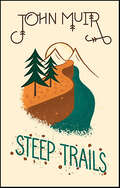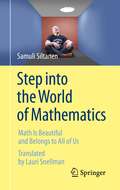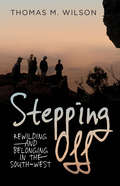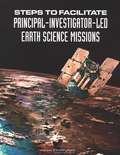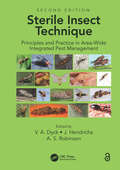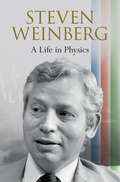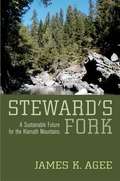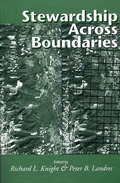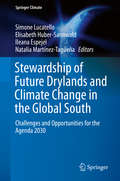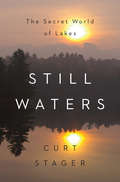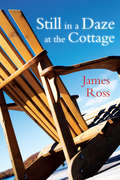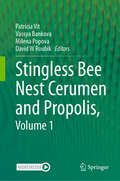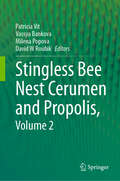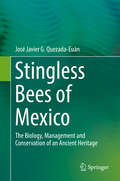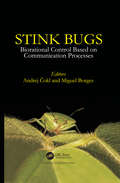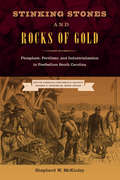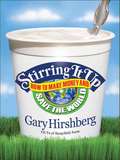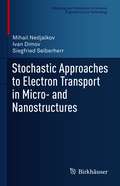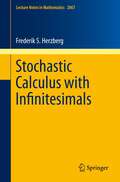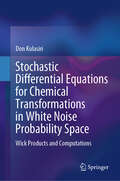- Table View
- List View
Steep Trails
by John MuirConsidered one of the patron saints of twentieth-century environmental activity, John Muir's appeal to modern readers is that he not only explored the American West but also fought for its preservation. Steep Trails collects together his essays and letters written as he traveled through the West, capturing the personal, heartfelt connection he had with the lands he roamed. His work takes the reader through the mountains and valleys of California, over the Cascades and the Wasatch Ranges, through Puget Sound and the forests of Washington and Oregon, and to the breathtaking Grand Canyon of Arizona. Muir’s writing intimately connects the reader to the heart of nature; as the world increasingly tries to reconnect with the earth, Steep Trails offers the funny, charming, educational, and exalted wanderings of John Muir over nearly three decades of his life.
Step into the World of Mathematics: Math Is Beautiful and Belongs to All of Us
by Samuli SiltanenModern life is increasingly relying on digital technology, which in turn runs on mathematics. However, this underlying math is hidden from us. That is mostly a good thing since we do not want to be solving equations and calculating fractions just to get things done in our everyday business. But the mathematical details do matter for anyone who wants to understand how stuff works, or wishes to create something new in the jungle of apps and algorithms. This book takes a look at the mathematical models behind weather forecasting, climate change prediction, artificial intelligence, medical imaging and computer graphics. The reader is expected to have only a curious mind; technical math skills are not needed for enjoying this text.
Stepping Off: Rewilding and Belonging in the South-West
by Thomas WilsonStepping Off is a book for locals and travellers alike. It is the story of the south-western corner of Western Australia: an environmental history, a social history, an invitation to reconnect with the land – and in doing so, to reconnect with ourselves.
Steps To Facilitate Principal-investigator-led Earth Science Missions
by Committee on Earth StudiesPrincipal-investigator (PI) Earth science missions are small, focused science projects involving relatively small spacecraft. The selected PI is responsible for the scientific and programmatic success of the entire project. A particular objective of PI-led missions has been to help develop university-based research capacity. Such missions, however, pose significant challenges that are beyond the capabilities of most universities to manage. To help NASA’s Office of Earth Science determine how best to address these, the NRC carried out an assessment of key issues relevant to the success of university-based PI-led Earth observation missions. This report presents the result of that study. In particular, the report provides an analysis of opportunities to enhance such missions and recommendations about whether and, if so, how they should be used to build university-based research capabilities.
Stereographic Projection Techniques for Geologists and Civil Engineers
by Richard J. Lisle Peter R. LeyshonThe stereographic projection is an essential tool in the fields of structural geology and geotechnics, which allows three-dimensional orientation data to be represented and manipulated. This book has been designed to make the subject as accessible as possible. It gives a straightforward and simple introduction to the subject and, by means of examples, illustrations and exercises, encourages the student to visualise the problems in three dimensions. Students of all levels will be able to work through the book and come away with a clear understanding of how to apply these vital techniques. This revised edition contains additional material on geotechnical applications, improved illustrations and links to useful web resources and software programs. It will provide students of geology, rock mechanics, geotechnical and civil engineering with an indispensable guide to the analysis and interpretation of field orientation data.
Sterile Insect Technique: Principles And Practice In Area-Wide Integrated Pest Management
by V. A. DyckThe sterile insect technique (SIT) is an environment-friendly method of pest control that integrates well into area-wide integrated pest management (AW-IPM) programmes. This book takes a generic, thematic, comprehensive, and global approach in describing the principles and practice of the SIT. The strengths and weaknesses, and successes and failures, of the SIT are evaluated openly and fairly from a scientific perspective. The SIT is applicable to some major pests of plant-, animal-, and human-health importance, and criteria are provided to guide in the selection of pests appropriate for the SIT. In the second edition, all aspects of the SIT have been updated and the content considerably expanded. A great variety of subjects is covered, from the history of the SIT to improved prospects for its future application. The major chapters discuss the principles and technical components of applying sterile insects. The four main strategic options in using the SIT — suppression, containment, prevention, and eradication — with examples of each option are described in detail. Other chapters deal with supportive technologies, economic, environmental, and management considerations, and the socio-economic impact of AW-IPM programmes that integrate the SIT. In addition, this second edition includes six new chapters covering the latest developments in the technology: managing pathogens in insect mass-rearing, using symbionts and modern molecular technologies in support of the SIT, applying post-factory nutritional, hormonal, and semiochemical treatments, applying the SIT to eradicate outbreaks of invasive pests, and using the SIT against mosquito vectors of disease. This book will be useful reading for students in animal-, human-, and plant-health courses. The in-depth reviews of all aspects of the SIT and its integration into AW-IPM programmes, complete with extensive lists of scientific references, will be of great value to researchers, teachers, animal-, human-, and plant-health practitioners, and policy makers.
Steven Weinberg: A Life in Physics
by Steven WeinbergSteven Weinberg shares his candid thoughts, in his own words, on theoretical physics and cosmology, along with personal anecdotes and recollections of the people who helped shape his career. These memoirs of his life as a scientist and public figure cover his student days and early career, through the golden age of particle physics in the 1970s, his being awarded the Nobel prize, through to the end of the twentieth century. In addition to his research insights, Weinberg provides glimpses into his life in academia more broadly: dealing with the 'two-body problem', tenure, international conference travel, his book-writing, advisory work with JASON, and his advocacy for the Superconducting Super Collider. Physicists, historians of science and interested readers will find the presentation engaging and often witty, as Weinberg reflects on his life in physics.
Steward's Fork: A Sustainable Future for the Klamath Mountains
by James K. AgeeThe book explores northwest California's magnificent Klamath Mountains--a region that boasts a remarkable biodiversity, a terrain so rugged that significant landscape features are still being discovered there, and a wealth of natural resources that have been used, and more recently abused, by humans for millennia.
Stewardship Across Boundaries
by Richard L. Knight Peter LandresEvery piece of land, no matter how remote or untrammeled, has a boundary. While sometimes boundary lines follow topographic or biological features, more often they follow the straight lines of political dictate and compromise. Administrative boundaries nearly always fragment a landscape, resulting in loss of species that must disperse or migrate across borders, increased likelihood of threats such as alien species or pollutants, and disruption of natural processes such as fire. Despite the importance and ubiquity of boundary issues, remarkably little has been written on the subject.Stewardship Across Boundaries fills that gap in the literature, addressing the complex biological and socioeconomic impacts of both public and private land boundaries in the United States. With contributions from natural resource managers, historians, environmentalists, political scientists, and legal scholars, the book:develops a framework for understanding administrative boundaries and their effects on the land and on human behavior examines issues related to different types of boundaries -- wilderness, commodity, recreation, private-public presents a series of case studies illustrating the efforts of those who have cooperated to promote stewardship across boundaries synthesizes the broad complexity of boundary-related issues and offers an integrated strategy for achieving regional stewardshi.Stewardship Across Boundaries should spur open discussion among students, scientists, managers, and activists on this important topic. It demonstrates how legal, social, and ecological conditions interact in causing boundary impacts and why those factors must be integrated to improve land management. It also discusses research needs and will help facilitate critical thinking within the scientific community that could result in new strategies for managing boundaries and their impacts.
Stewardship of Future Drylands and Climate Change in the Global South: Challenges and Opportunities for the Agenda 2030 (Springer Climate)
by Simone Lucatello Elisabeth Huber-Sannwald Ileana Espejel Natalia Martínez-TagüeñaThis volume integrates a conceptual framework with participatory methodologies to understand the complexities of dryland socio-ecological systems, and to address challenges and opportunities for stewardship of future drylands and climate change in the global south. Through several case studies, the book offers a transdisciplinary and participatory approach to understand the complexity of socio-ecological systems, to co-produce accurate resource management plans for sustained stewardship, and to drive social learning and polycentric governance. This systemic framework permits the study of human-nature interrelationships through time and in particular contexts, with a focus on achieving progress in accordance with the 2030 United Nations Agenda for Sustainable Development. The book is divided into four main sections: 1) drylands and socio-ecological systems, 2) transdisciplinarity in drylands, 3) interculturality in drylands, and 4) the governance of drylands. Expert contributors address topics such as pastoralism and the characteristics of successful agricultural lands, the sustainable development goals and drylands, dryland modernization, and arid land governance with a focus on Mexico. The volume will be of interest to dryland researchers, sustainable development practitioners and policymakers.
Still Waters: The Secret World Of Lakes
by Curt StagerA fascinating exploration of lakes around the world, from Walden Pond to the Dead Sea. More than a century and a half have passed since Walden was first published, and the world is now a very different place. Lakes are changing rapidly, not because we are separate from nature but because we are so much a part of it. While many of our effects on the natural world today are new, from climate change to nuclear fallout, our connections to it are ancient, as core samples from lake beds reveal. In Still Waters, Curt Stager introduces us to the secret worlds hidden beneath the surfaces of our most remarkable lakes, leading us on a journey from the pristine waters of the Adirondack Mountains to the wilds of Siberia, from Thoreau’s cherished pond to the Sea of Galilee. Through decades of firsthand investigations, Stager examines the significance of our impacts on some of the world’s most iconic inland waters. Along the way he discovers the stories these lakes contain about us, including our loftiest philosophical ambitions and our deepest myths. For him, lakes are not only mirrors reflecting our place in the natural world but also windows into our history, culture, and the primal connections we share with all life. Beautifully observed and eloquently written, Stager’s narrative is filled with strange and enchanting details about these submerged worlds—diving insects chirping underwater like crickets, African crater lakes that explode, and the growing threats to some of our most precious bodies of water. Modern science has demonstrated that humanity is an integral part of nature on this planet, so intertwined with it that we have also become an increasingly powerful force of nature in our own right. Still Waters reminds us how beautiful, complex, and vulnerable our lakes are, and how, more than ever, it is essential to protect them.
Still in a Daze at the Cottage
by James RossMore tales of family fun and run-ins with nature at the cottage. In the sequel to Cottage Daze, James Ross is back with more tales from the family cottage. Organized by nature’s changing seasons and containing sections covering nature, family, activity, and the cottage, Ross combines wry humour with a genuine love for adventure and respect for the natural world — although the local wild animal population can try his patience. Ross’s anecdotes are full of good spirits and sound advice, whether he is describing a visit from his daughter’s special friend ("The Boyfriend Cometh"), the tricky practices of boating ("Dressing Up for Kayaking"), or encounters with wildlife both big and small ("The Frog Whisperer"). This book is the perfect companion to the time-honoured tradition of wilderness family getaways.
Stingless Bee Nest Cerumen and Propolis, Volume 1
by Patricia Vit Milena Popova Vassya Bankova David W RoubikMeliponini, the stingless bees of the tropics, process and store honey, pollen and plant resins to maintain their colonies. The chemical components of their nests are bioactive and believed to be therapeutic for a long list of maladies. However, only recently are tests and analyses being done with molecular and modern laboratory techniques, such as high throughput EDX, HPIC, HPLC, GC, NMR, PCR, and ultrastructural SEM; coupled with diverse detectors such as DAD, RI, MS, SCD.This two-volume book is about the cerumen –plant resins mixed with stingless bee wax– and propolis, which fortify the colony in ways that are beginning to be understood. It includes reviews and new research on diverse topics involving the chemistry and bioactivity of plant resins, cerumen, propolis, besides bee and microbe behavior and ecology. These analytic studies are presented along with stingless bee biodiversity, palynology, cultural knowledge, bee foraging behavior, resin flower evolution, ecology, and evolution of nest microbe mutualisms, social immunity, human health, the decisive role of microbiology investigation in moving forward, natural history of stingless bee colonies and nests, marketing, and bibliometrics for plant resin use by bees, propolis, and the Starmerella yeast.
Stingless Bee Nest Cerumen and Propolis, Volume 2
by Patricia Vit Milena Popova Vassya Bankova David W RoubikMeliponini, the stingless bees of the tropics, process and store honey, pollen and plant resins to maintain their colonies. The chemical components of their nests are bioactive and believed to be therapeutic for a long list of maladies. However, only recently are tests and analyses being done with molecular and modern laboratory techniques, such as high throughput EDX, HPIC, HPLC, GC, NMR, PCR, and ultrastructural SEM; coupled with diverse detectors such as DAD, RI, MS, SCD.This two-volume book is about the cerumen –plant resins mixed with stingless bee wax– and propolis, which fortify the colony in ways that are beginning to be understood. It includes reviews and new research on diverse topics involving the chemistry and bioactivity of plant resins, cerumen, propolis, besides bee and microbe behavior and ecology. These analytic studies are presented along with stingless bee biodiversity, palynology, cultural knowledge, bee foraging behavior, resin flower evolution, ecology, and evolution of nest microbe mutualisms, social immunity, human health, the decisive role of microbiology investigation in moving forward, natural history of stingless bee colonies and nests, marketing, and bibliometrics for plant resin use by bees, propolis, and the Starmerella yeast.
Stingless Bees of Mexico
by José Javier Quezada-EuánThe stingless bees are the most diverse group of highly social bees and are key species in our planet’s tropical and subtropical regions, where they thrive. In Mexico, the management of stingless bees dates back centuries, and they were an essential part of the culture and cosmogony of native peoples like the Maya. In recent decades a vast amount of information has been gathered on stingless bees worldwide. This book summarizes various aspects of the biology and management of stingless bees, with special emphasis on the Mexican species and the traditions behind their cultivation. Much of the information presented here was produced by the author and the team of researchers at the Universidad Autónoma de Yucatán in the course of three decades of working with these insects. Given the breadth of its coverage, the book offers an equally valuable reference guide for academics, students and beekeepers alike.
Stinkbugs: Biorational Control Based on Communication Processes
by Andrej Cokl Miguel BorgesThis book presents an overview of the Pentatomidae species, covering their biology, phylogeny and reproductive behavior, main plants used in their diet and their nutritional exigencies, predatory stinkbugs, interactions between herbivores-plants and natural enemies, use of pheromone for monitoring phytophagous populations, and chemical and vibrational communication signals. It also presents possible technologies to be applied in field crops for pest management that could be developed as the basis of the interplay of stink bug communication signals.
Stinking Stones and Rocks of Gold: Phosphate, Fertilizer, and Industrialization in Postbellum South Carolina (New Perspectives on the History of the S)
by Shepherd W McKinleySouth Carolina Historical Society George C. Rogers Jr. Book Award "A solid contribution."--Journal of American History "An insightful analysis of the rise of the phosphate and fertilizer industries in the South Carolina lowcountry."--Business History Review "Places the rise of these industries in the context of the struggle for southern economic leadership in the years following the Civil War. . . . A well-written, engaging history."--Journal of Economic History "McKinley posits that the fertilizer industry emancipated former planter elites from the slave-based antebellum economy. . . . Ultimately, manufactured fertilizer contributed to fundamental changes in southern agriculture."--American Historical Review "A significant contribution to the story of industrialization in the New South."--Choice "Illustrates how South Carolina’s abundant phosphate deposits bred vibrant mining and fertilizer industries in Charleston and adjacent environs that helped reshape land, labor, and economy in the heartland of the former Confederacy."--Journal of Southern History "A finely layered and important study that fills in gaps in the industrial history of the New South and especially low-country South Carolina."--Sidney Bland, author of Preserving Charleston's Past, Shaping Its Future: The Life and Times of Susan Pringle Frost "Skillfully blurs the old, comfortable line between Old and New South economies and paints a nuanced picture of the new labor relations in the post-slavery era."--Charles Holden, author of In the Great Maelstrom In the first book ever written about the impact of phosphate mining on the South Carolina plantation economy, Shepherd McKinley explains how the convergence of the phosphate and fertilizer industries carried long-term impacts for America and the South. Fueling the rapid growth of lowcountry fertilizer companies, phosphate mining provided elite plantation owners a way to stem losses from emancipation. At the same time, mining created an autonomous alternative to sharecropping, enabling freed people to extract housing and labor concessions. Stinking Stones and Rocks of Gold develops an overarching view of what can be considered one of many key factors in the birth of southern industry. This top-down, bottom-up history (business, labor, social, and economic) analyzes an alternative path for all peoples in the post-emancipation South.
Stirring It Up: How to Make Money and Save the World
by Gary HirshbergA true force for change, Gary Hirshberg has been at the forefront of movements working for environmental and social transformation for 30 years. From his early days as an educator and activist to his current position as President and CE-Yo of Stonyfield Farm, the world's largest organic yogurt company, Hirshberg's positive outlook has inspired thousands of people to recognize their ability to make the world a better place.In Stirring It Up, Hirshberg calls on individuals to realize their power to effect change in the marketplace--"the power of one"--while proving that environmental commitment makes for a healthier planet and a healthier bottom line. Drawing from his 25 years' experience growing Stonyfield Farm from a 7-cow start-up, as well as the examples of like-minded companies, such as Newman's Own, Patagonia, Wal-Mart and Timberland, Hirshberg presents stunning evidence that business not only can save the planet, but is able to simultaneously deliver higher growth and superior profits as well.Hirshberg illustrates his points with practical information and advice, as well as engaging anecdotes from what he calls "the bad old days" of his yogurt company: how a power outage left him milking cows by hand, how a dumpster fire revealed the need for better packaging, and his camel manure taste test challenge to a local shock jock. He also describes hands-on grassroots marketing strategies--printing yogurt lids with provocative, politically charged messages, handing out thousands of free samples to subway commuters to thank them for using public transit, and devising the country's first organic vending machine--explaining how these approaches make a much more powerful impact on consumers than traditional advertising.An inspiring book for business owners and managers as well as anyone interested in saving the environment, Stirring It Up demonstrates how companies can work to save the planet, while achieving greater profits and satisfaction, and how we can all use the power of conscious consumption to encourage green corporate behavior.
Stochastic Analysis of Offshore Steel Structures
by Halil KaradenizStochastic Analysis of Offshore Steel Structures provides a clear and detailed guide to advanced analysis methods of fixed offshore steel structures using 3D beam finite elements under random wave and earthquake loadings. Advanced and up-to-date research results are coupled with modern analysis methods and essential theoretical information to consider optimal solutions to structural issues. As these methods require and use knowledge of different subject matters, a general introduction to the key areas is provided. This is followed by in-depth explanations supported by design examples, relevant calculations and supplementary material containing related computer programmers. By combining this theoretical and practical approach Stochastic Analysis of Offshore Steel Structures cover a range of key concepts in detail including: The basic principles of standard 3D beam finite elements and special connections, Wave loading - from hydrodynamics to the calculation of wave loading on structural members, Stochastic response calculations with corresponding solution algorithms including earthquakes, and Fatigue damage, reliability calculation and reliability based design optimization. The broad and detailed coverage makes this a solid reference for research oriented studies and practical sophisticated design methods. Students, researchers, insuring bodies and practical designer offices can turn to Stochastic Analysis of Offshore Steel Structures to broaden their theoretical understanding and develop their practical designs and applications of 3D finite analysis in fixed offshore steel structures.
Stochastic Approaches to Electron Transport in Micro- and Nanostructures (Modeling and Simulation in Science, Engineering and Technology)
by Ivan Dimov Siegfried Selberherr Mihail NedjalkovThe book serves as a synergistic link between the development of mathematical models and the emergence of stochastic (Monte Carlo) methods applied for the simulation of current transport in electronic devices. Regarding the models, the historical evolution path, beginning from the classical charge carrier transport models for microelectronics to current quantum-based nanoelectronics, is explicatively followed. Accordingly, the solution methods are elucidated from the early phenomenological single particle algorithms applicable for stationary homogeneous physical conditions up to the complex algorithms required for quantum transport, based on particle generation and annihilation. The book fills the gap between monographs focusing on the development of the theory and the physical aspects of models, their application, and their solution methods and monographs dealing with the purely theoretical approaches for finding stochastic solutions of Fredholm integral equations.
Stochastic Averaging: Methods and Applications, Volume 1
by Wei-Qiu Zhu Mao-Lin Deng Guo-Qiang CaiThe stochastic averaging methods are among the most effective and widely applied approximate methods for studying nonlinear stochastic dynamics. Upon an overview of global research on the subject, the book highlights a comprehensive summary of research results obtained by the group led by Professor Weiqiu Zhu at Zhejiang University in China and the group led by Professors Y. K. Lin and G. Q. Cai at Florida Atlantic University in the USA over the past three decades. The books are structured to progress logically from foundational principles to simple problems and then to increasingly complex applications. To facilitate understanding and mastery of the methods, the books offer essential preliminary knowledge and a wealth of examples. The book comprises two volumes. Volume 1 introduces the basic principles of stochastic averaging methods and their applications to single-degree-of-freedom systems under various random excitations. It also covers stochastic averaging methods for quasi-Hamiltonian systems subjected to different random excitations, including Gaussian white noise, combined Gaussian and Poisson white noises, and fractional Gaussian noise. Volume 2 explores stochastic averaging methods for quasi-integrable Hamiltonian systems under colored noise excitation, quasi-integrable Hamiltonian systems with genetic effects under Gaussian white noise and colored noise excitations, and quasi-generalized Hamiltonian systems under Gaussian white noise excitation. Additionally, it covers applications of these methods in ecosystems and some other natural science and engineering scenarios. These books serve as both introductory texts and valuable reference resources for readers in higher education and research institutions who are interested in or actively engaged in research involving nonlinear stochastic dynamics. The fields covered include mechanics, physics, chemistry, biology, ecology, astronautics and aeronautics, oceanography, civil engineering, mechanical engineering, and electrical engineering.
Stochastic Calculus and Differential Equations for Physics and Finance
by Joseph L. MccauleyStochastic calculus provides a powerful description of a specific class of stochastic processes in physics and finance. However, many econophysicists struggle to understand it. This book presents the subject simply and systematically, giving graduate students and practitioners a better understanding and enabling them to apply the methods in practice. The book develops Ito calculus and Fokker-Planck equations as parallel approaches to stochastic processes, using those methods in a unified way. The focus is on nonstationary processes, and statistical ensembles are emphasized in time series analysis. Stochastic calculus is developed using general martingales. Scaling and fat tails are presented via diffusive models. Fractional Brownian motion is thoroughly analyzed and contrasted with Ito processes. The Chapman-Kolmogorov and Fokker-Planck equations are shown in theory and by example to be more general than a Markov process. The book also presents new ideas in financial economics and a critical survey of econometrics.
Stochastic Calculus with Infinitesimals
by Frederik S. HerzbergStochastic analysis is not only a thriving area of pure mathematics with intriguing connections to partial differential equations and differential geometry. It also has numerous applications in the natural and social sciences (for instance in financial mathematics or theoretical quantum mechanics) and therefore appears in physics and economics curricula as well. However, existing approaches to stochastic analysis either presuppose various concepts from measure theory and functional analysis or lack full mathematical rigour. This short book proposes to solve the dilemma: By adopting E. Nelson's "radically elementary" theory of continuous-time stochastic processes, it is based on a demonstrably consistent use of infinitesimals and thus permits a radically simplified, yet perfectly rigorous approach to stochastic calculus and its fascinating applications, some of which (notably the Black-Scholes theory of option pricing and the Feynman path integral) are also discussed in the book.
Stochastic Differential Equations for Chemical Transformations in White Noise Probability Space: Wick Products and Computations
by Don KulasiriThis book highlights the applications of stochastic differential equations in white noise probability space to chemical reactions that occur in biology. These reactions operate in fluctuating environments and are often coupled with each other. The theory of stochastic differential equations based on white noise analysis provides a physically meaningful modelling framework. The Wick product-based calculus for stochastic variables is similar to regular calculus; therefore, there is no need for Ito calculus. Numerical examples are provided with novel ways to solve the equations. While the theory of white noise analysis is well developed by mathematicians over the past decades, applications in biophysics do not exist. This book provides a bridge between this kind of mathematics and biophysics.
Stochastic Flood Forecasting System
by Renata J. Romanowicz Marzena OsuchThis book presents the novel formulation and development of a Stochastic Flood Forecasting System, using the Middle River Vistula basin in Poland as a case study. The system has a modular structure, including models describing the rainfall-runoff and snow-melt processes for tributary catchments and the transformation of a flood wave within the reach. The sensitivity and uncertainty analysis of the elements of the study system are performed at both the calibration and verification stages. The spatial and temporal variability of catchment land use and river flow regime based on analytical studies and measurements is presented. A lumped parameter approximation to the distributed modelling of river flow is developed for the purpose of flow forecasting. Control System based emulators (Hammerstein-Wiener models) are applied to on-line data assimilation. Medium-range probabilistic weather forecasts (ECMWF) and on-line observations of temperature, precipitation and water levels are used to prolong the forecast lead time. The potential end-users will also benefit from a description of social vulnerability to natural hazards in the study area.
